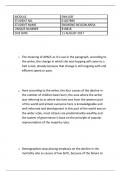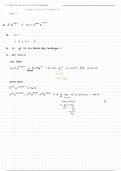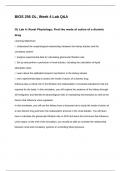Studen
ts
The cliched “Not tonight” brings to mind the speaker refusing the
sexual advances of a partner. Coupled with “I’m dreaming”, this
A dreaming week could suggest the poem is about dissatisfaction with a
lover/relationship, and the dark being a welcoming place for
fantasy and dreaming of someone else.
Not tonight, I'm dreaming
sweet
in the heart of the honeyed dark
Symbolises love and warmth in a boat of a bed in the attic room
in a house on the edge of the park typical important space for
where the wind in the big old trees women in literature (for example,
The references to “boat” and “ark”
creaks like an ark. The Yellow Wallpaper)
suggest a journey, or time of discovery
for the speaker. However, the Ark in
the Bible is used to survive a time of
devastation and turmoil, so this could
imply darker, more urgent motives for
escaping from reality.
The first line of the poem uses enjambement to flow quickly on to the next. In doing this, Duffy creates a
dreamlike flow early in the poem, using this technique to influence the reception of the poem. The carefree
flowing from line to line allows for words to blur together, emulating a dreamy state.
The location of ‘a bed in the attic’ could be interpreted as bearing reference to the trope of the Mad Woman in
the Attic. This trope, seen across texts like Yellow Wallpaper and Jane Eyre, pushes women into small and
unseen places. Duffy could be using this reference to discuss the treatment of women within society, a theme
prominent in her work. If you are interested in reading more about this trope, Sandra Gilbert and Susan
Gubar’s ‘The Mad Woman in The Attic’ is a great place to start.
The semantics of methods of transport permeates the poem, ‘boat’, and ‘ark’ being prominent in the first
stanza. Duffy is focusing on escapism, using these words to reference a type of journey. By referencing the
‘ark’, Duffy could be drawing upon the biblical story. This could symbolize the beginning of a new relationship
or chapter in Duffy’s life. She leaves behind her old relationship, withdrawing into the safety of the ‘ark’.
Nature is a comforting force within the poem, both here in the first stanza and onwards throughout the rest.
The reference to the ‘big old trees’ gives a sense of familiarity, Duffy looking for support in these dark times.
Duffy subverts the reader’s Not tomorrow, I'm dreaming
till dusk turns to dawn - dust, must, A bird is associated with
expectations through the use of a
most, moot, moon, mown, down - freedom, and so Duffy is
clever pun. Dusk turning to dawn is
with my hand over an open unread book, describing a book as a sort of
often used to indicate the passing of
a bird that's never flown . . . distantly escape, a freedom from life.
the night, but Duffy takes the
the birdsong of a telephone. However a flightless bird has no
meaning of turning the words into
freedom, implying that the
each other by changing one letter to
book wants to be read, to be
form a new word. She uses wordplay
set free itself. There is a sense
to create a feeling that the speaker is
of sadness in an unread book.
playful.
Studen
ts
, Studen
ts
The internal rhyme across ‘dust, must’ surges the poem onwards. Similar to the enjambment within the first
stanza, this structural technique helps to build the tone of the poem. The ringing repetition of assonance
across ‘dust, must’ creates a cohesion, floating the poem forward.
Duffy presents literature as a form of freedom. The association of ‘book’ and ‘a bird’ is metaphorical for the
freedom that literature gives to someone. Duffy uses this as escapism, suggesting that an unread book is
simply ‘a bird that’s never flown’. The use of ‘flown’ stems from the semantics of flying, Duffy suggesting that
literature can transport you out of your situations.
One lens of femininity, the moon
often symbolises femininity and the With the earlier comparison of a
Not the following evening, I'm dreaming
singularity of the Monocle creates this book and a bird, here Duffy is
in the monocle of the moon,
impression. A dangerous, vulnerable presenting the speaker’s
a sleeping S on the page of a bed
Impression- woman could be bedroom as a freedom. This
in the tome of a dim room, the rain
exploited. on the roof, rhyming there, subverts the reader’s natural
like the typed words of a poem expectations as usually we would
consider a room to be enclosed,
a place of entrapment.
A similar melancholic tone permeates within images of ‘the moon’ and ’sleeping’. The drowsy state Duffy
experiences could be interpreted as simply tired due to the lateness. Yet, Duffy could also be referencing a
melancholic numbing, the approaching end of her relationship upsetting the poet. The feminine ‘moon’ is all-
seeing, the use of ‘monocle’ giving the feminine symbol vision to watch the scene. This is again a comforting
image, Duffy connecting with the symbol to provide support. The drowsy consonance of ‘m’ across ‘monocle’
and ‘moon’ further this idea, the words flowing comfortable into one another. This is repeated with sibilance
on the following line, ‘sleeping S’ conjuring a drowsy aural quality.
Here Duffy refers to the fact
that we don’t see stars in real- Idiomatic phrases. Repeating
time. It can take years, even yourself till you’re blue in the
centuries, millennia for the light Not the night after that, I'm dreaming
till the stars are blue in the face
face.
of some stars to reach earth. It could also symbolise her
The light from our own sun printing the news of their old light
with the ink of space, reluctancy to have intercourse.
takes 8 minutes to reach us.
yards and yards of black silk night
to cover my sleeping face.
Duffy’s use of rhyme across ‘face’ and ‘space’ furthers the dreamlike tone created earlier in the poem. The
reference to the ‘stars’ that are ‘printing the news of their old light’ again provides comfort. Alike the ‘big old
tree’ of the first stanza, nature is presented as a constant force of comfort. The stars, light years away, still
provide a beautiful quality of light to bathe the scene, comforting the poet.
Studen
ts
ts
The cliched “Not tonight” brings to mind the speaker refusing the
sexual advances of a partner. Coupled with “I’m dreaming”, this
A dreaming week could suggest the poem is about dissatisfaction with a
lover/relationship, and the dark being a welcoming place for
fantasy and dreaming of someone else.
Not tonight, I'm dreaming
sweet
in the heart of the honeyed dark
Symbolises love and warmth in a boat of a bed in the attic room
in a house on the edge of the park typical important space for
where the wind in the big old trees women in literature (for example,
The references to “boat” and “ark”
creaks like an ark. The Yellow Wallpaper)
suggest a journey, or time of discovery
for the speaker. However, the Ark in
the Bible is used to survive a time of
devastation and turmoil, so this could
imply darker, more urgent motives for
escaping from reality.
The first line of the poem uses enjambement to flow quickly on to the next. In doing this, Duffy creates a
dreamlike flow early in the poem, using this technique to influence the reception of the poem. The carefree
flowing from line to line allows for words to blur together, emulating a dreamy state.
The location of ‘a bed in the attic’ could be interpreted as bearing reference to the trope of the Mad Woman in
the Attic. This trope, seen across texts like Yellow Wallpaper and Jane Eyre, pushes women into small and
unseen places. Duffy could be using this reference to discuss the treatment of women within society, a theme
prominent in her work. If you are interested in reading more about this trope, Sandra Gilbert and Susan
Gubar’s ‘The Mad Woman in The Attic’ is a great place to start.
The semantics of methods of transport permeates the poem, ‘boat’, and ‘ark’ being prominent in the first
stanza. Duffy is focusing on escapism, using these words to reference a type of journey. By referencing the
‘ark’, Duffy could be drawing upon the biblical story. This could symbolize the beginning of a new relationship
or chapter in Duffy’s life. She leaves behind her old relationship, withdrawing into the safety of the ‘ark’.
Nature is a comforting force within the poem, both here in the first stanza and onwards throughout the rest.
The reference to the ‘big old trees’ gives a sense of familiarity, Duffy looking for support in these dark times.
Duffy subverts the reader’s Not tomorrow, I'm dreaming
till dusk turns to dawn - dust, must, A bird is associated with
expectations through the use of a
most, moot, moon, mown, down - freedom, and so Duffy is
clever pun. Dusk turning to dawn is
with my hand over an open unread book, describing a book as a sort of
often used to indicate the passing of
a bird that's never flown . . . distantly escape, a freedom from life.
the night, but Duffy takes the
the birdsong of a telephone. However a flightless bird has no
meaning of turning the words into
freedom, implying that the
each other by changing one letter to
book wants to be read, to be
form a new word. She uses wordplay
set free itself. There is a sense
to create a feeling that the speaker is
of sadness in an unread book.
playful.
Studen
ts
, Studen
ts
The internal rhyme across ‘dust, must’ surges the poem onwards. Similar to the enjambment within the first
stanza, this structural technique helps to build the tone of the poem. The ringing repetition of assonance
across ‘dust, must’ creates a cohesion, floating the poem forward.
Duffy presents literature as a form of freedom. The association of ‘book’ and ‘a bird’ is metaphorical for the
freedom that literature gives to someone. Duffy uses this as escapism, suggesting that an unread book is
simply ‘a bird that’s never flown’. The use of ‘flown’ stems from the semantics of flying, Duffy suggesting that
literature can transport you out of your situations.
One lens of femininity, the moon
often symbolises femininity and the With the earlier comparison of a
Not the following evening, I'm dreaming
singularity of the Monocle creates this book and a bird, here Duffy is
in the monocle of the moon,
impression. A dangerous, vulnerable presenting the speaker’s
a sleeping S on the page of a bed
Impression- woman could be bedroom as a freedom. This
in the tome of a dim room, the rain
exploited. on the roof, rhyming there, subverts the reader’s natural
like the typed words of a poem expectations as usually we would
consider a room to be enclosed,
a place of entrapment.
A similar melancholic tone permeates within images of ‘the moon’ and ’sleeping’. The drowsy state Duffy
experiences could be interpreted as simply tired due to the lateness. Yet, Duffy could also be referencing a
melancholic numbing, the approaching end of her relationship upsetting the poet. The feminine ‘moon’ is all-
seeing, the use of ‘monocle’ giving the feminine symbol vision to watch the scene. This is again a comforting
image, Duffy connecting with the symbol to provide support. The drowsy consonance of ‘m’ across ‘monocle’
and ‘moon’ further this idea, the words flowing comfortable into one another. This is repeated with sibilance
on the following line, ‘sleeping S’ conjuring a drowsy aural quality.
Here Duffy refers to the fact
that we don’t see stars in real- Idiomatic phrases. Repeating
time. It can take years, even yourself till you’re blue in the
centuries, millennia for the light Not the night after that, I'm dreaming
till the stars are blue in the face
face.
of some stars to reach earth. It could also symbolise her
The light from our own sun printing the news of their old light
with the ink of space, reluctancy to have intercourse.
takes 8 minutes to reach us.
yards and yards of black silk night
to cover my sleeping face.
Duffy’s use of rhyme across ‘face’ and ‘space’ furthers the dreamlike tone created earlier in the poem. The
reference to the ‘stars’ that are ‘printing the news of their old light’ again provides comfort. Alike the ‘big old
tree’ of the first stanza, nature is presented as a constant force of comfort. The stars, light years away, still
provide a beautiful quality of light to bathe the scene, comforting the poet.
Studen
ts







